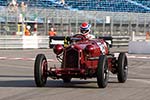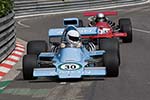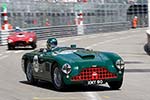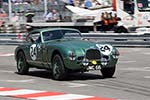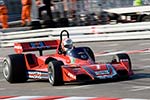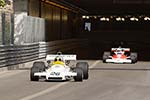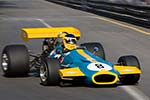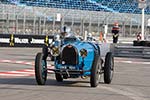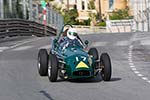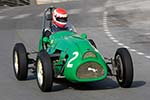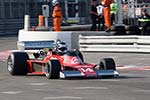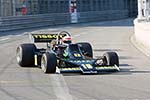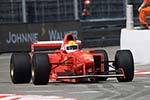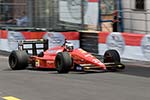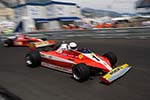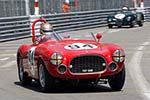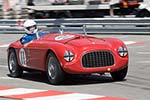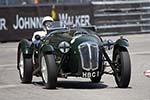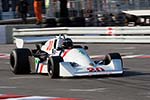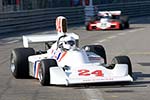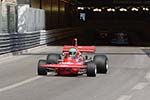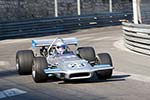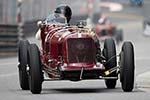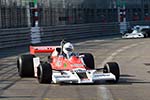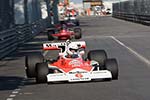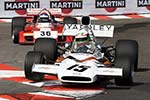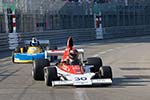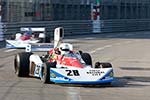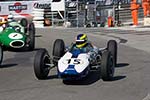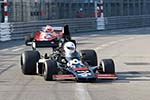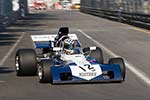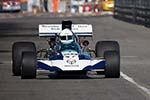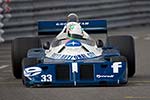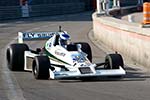Introduction

A win in a Formula 1 car at Monaco ranks very high among motor racing aficionados. Until recently only racing drivers the likes of Ayrton Senna, Graham Hill and Stirling Moss were able to claim victory in the Principality. Among them they won no fewer than 14 times, underlining that only the greatest are successful on the tricky street circuit. Almost as famous are the many accidents like Albert Ascari's d(r)ive into the harbour in 1955. To give the slightly less talented enthusiasts a chance to aim for an F1 win at Monaco, the Automobile Club de Monaco (ACM) first organized the Monaco Historic Grand Prix in 1997. The now bi-annual event was held for the sixth time in 2008. Looking back at past winners there is a clear resemblance with the 'real' Monaco Grand Prix; the same names pop up as winners time and again. Most successful of all was Martin Stretton, who had won at least one race at each of the previous editions. Last time we saw him, at the 2007 Goodwood Revival, he was rushed to hospital, but fortunately he recovered fully in time to try and continue his winning streak.
Following the schedule adopted in 2006 there were seven different races; six for single seaters and one for sports cars. The only difference was that this time round the Formula Junior race was open for front-engined machines instead of the mid-engined cars that took to the track two years ago. On Saturday each group was given two twenty minute sessions to determine the grid positions for Sunday's races, which were ten laps for the first five groups and fifteen for the quickest two groups.
In between sessions various historic cars and two Spykers were let loose on the track to give the lucky few passengers a first hand experience of the daunting track; it was quite exhilarating! The lunch-break was filled on both days by a demonstration of Ferrari F1 cars ranging from the 1950s Ferrari 500 to several of Michael Schumacher's championship winning machines.
Below you can find a race by race account of each race's highlights as well as a small account of the Bonhams auction that was held on Saturday evening in the local car museum, which houses the collection of Monaco's royal family. The article is well illustrated by a spectacular
200-shot slideshow.
Les Grandes Marques à Monaco
Auctioneer Bonhams established their traditional Monaco 'Les Grandes Marques' sale long before the Historic Grand Prix and this year celebrated their 14th anniversary. After acquiring Christie's motoring department late last year, Bonhams is now the largest Europe based auctioneer and that was reflected by the nicely varied and high quality lots displayed in the 'Musée de la Collection de Voitures de SAS le Prince de Monaco'.
The absolute highlight of the auction was a Bugatti Type 55, which combines a race-bred chassis with a beautiful Jean Bugatti designed roadster body. With less than 40 examples built, a Type 55 is already very rare, but the offered example also boasted Le Mans racing history. It found a new owner for just over €2,000,000.
Our attention was grabbed by a nice selection of Group B rally cars that included both competition versions of the cars as well as thinly disguised road-going homologation specials. Particularly interesting was the ex-Works Peugeot 205, which after its racing career was fully restored by the factory and displayed in the Peugeot museum. It was only sold to its first owner a few months ago and was offered in a virtually brand new condition. This warranted a high reserve, which unfortunately was not met by the interested parties.
Other notable results included an Aston Martin DB2 Vantage selling for well over the top estimate at €161,000, a Mercedes Benz 300 SL 'Gullwing' that found a new owner for €359,500, an achingly beautiful €238,500 Maserati Mistral Spyder and a superb and very rare Ferrari 365 GTS that sold for €500 under its €800,000 estimate.
Race A: Pre 1947 Voiturettes and Grand Prix cars
The very first Monaco Grand Prix was held in 1929 and was won by 'Williams' (William Grover) in a Bugatti Type 35B. The reason for the picking the seemingly unlikely street course was that the ACM could only host a Grand Prix if it was held entirely inside the country of Monaco. Although there were no cars present from that very first Grand Prix, many examples that raced through the streets of Monaco the following years lined up for Race A. Among them was the Alfa Romeo Tipo B / P3 that was used extensively by Scuderia Ferrari and raced to second in 1934. Matt Grist repeated that performance, beaten only by the ERA R4D of Julian Bronson. Despite being the oldest and most original car out on track, Duncan Pittaway's Bugatti Type 35T outpaced most of his much more modern rivals. He saw his spirited drive awarded with a fine eight place finish.
Race B: Pre 1961 front engined Grand-Prix cars
The second group saw American Duncan Dayton and Spaniard Joaquin Folch-Russinol go head to head for the first time of the weekend. Both in a Lotus 16 they were well ahead of the field. Sadly Folch could not challenge Dayton and was forced to end the race prematurely. A more closely matched fight was on behind the American with Barrie Baxter in the unique Tec-Mec Maserati and Tony Smith in his Ferrari 246 Dino. Baxter had been faster in qualifying and seemed to pull away right after the start. Getter quicker and quicker Smith closed right up to the Tec-Mec's tail and finally got by. The glory was short lived as in the final lap Baxter used the backmarkers to his advantage and clinched second. A notable entry, which unfortunately did not make it to the grid was Peter Heuberger's Maserati 250 F. That very car was piloted to victory back in 1956 by Stirling Moss.
Race C: Pre 1953 sports and sports prototype cars
Stirling Moss was also the focal point of the sole sports car race of the weekend. This was a celebration of the one time that the Monaco Grand Prix was not held for single seaters; in 1952. Moss qualified on the first row back then and he lined up again over half a century later in Frank Sytner's Frazer Nash Le Mans Replica. As a tribute, he was allowed to take a head start, giving the crowd a great opportunity to see the living legend at work once more. To get a fair result his first lap did not count, so he was well behind the rest of the field from the start, he nevertheless passed several cars to finish a commendable 18th. Like last time around, the race was won by John Ure in his Mk2 Frazer Nash Le Mans Replica. Taking seventh was Jose Fernandez in the very Ferrari 225S that was driven to victory in 1952 by Vittorio Marzotto.
Race D: Formula Junior Cars
Always a popular class, Formula Junior celebrates its fiftieth anniversary this year. The feeder series set up Count Johnny Lurani in 1958 to breed a new generation certainly paid off with the likes of Lorenzo Bandini and Jim Clark getting their first taste of single seater racing in a Formula Junior car. For the Golden Jubilee FJ-guru Duncan Rabagliati selected a fine mix of front-engined examples that raced in the first years, including at the 1959 Grand Prix de Junior Monaco. Among them was the Elva 100 raced by Bernie Ecclestone at Monaco in 1961. One of the most unusual examples was the V4 engined Lancia Dagrada entered by Andrea Giuliani. The race was a relatively easy prey for John Monson in his BMC Mk1. After storming past pole-man Tony Goodwin in a Gemini Mk2 from the line he never looked back.
Race E: Pre 1966 rear engined Formula 1 Grand Prix cars
Shortly after the mid-engined revolution changed the outlook of Formula 1, the sport's governing body cut the displacement limit to a mere 1.5 litre for the period between 1961 and 1965. The low output engines placed emphasis on chassis design more than ever before and probably since. The result was a series of very high tech machines that today are rarely campaigned. Fortunately they were out in force headlined by a series of Climax and BRM V8 engined cars. Amazingly Simon Hadfield managed to pip all of them in his four-cylinder engined ex-Jim Clark Lotus 21. At one point in the race he looked to be under siege from 'Fearless' Frank Sytner in a V8 engined Lotus 24 (also prepared by Hadfield), but Sytner was forced to retire before he could challenge Hadfield. This cleared the path to the podium for James Hanson in the rare Scirocco BRM and Marcus Mussa in a Lotus 24 BRM.
Race F: Pre 1975 Formula One 3 litres unsupercharged
Where the previous period saw great improvements in chassis and suspension design, the immediate years after 1965 saw the introduction of aerodynamic aids. Race F gave a great reflection of the big steps forward made by comparing the completely 'clean' Ferrari 312 of 1967 with the well winged Hesketh 308 of 1974. In this 15 lap race we saw part two of the Dayton / Folch show down with the American taking pole in his Brabham BT33, just 0.2 of a second ahead of Folch's McLaren M23. The two were nose to tail throughout the race and eventually crossed the line with smallest of margins with Dayton taking his second win of the day. Third was for Manfredo Rossi di Montelera in his Brabham BT42/44 painted in the 'family colours' of Martini & Rossi. Providing with some variation from the Cosworth engined machines and great aural pleasure were three V12 engined Matras. Yves Saguato finished seventh in the fastest of the bunch, taking home the class trophy.
Race G: Formula One 3 litres unsupercharged from 1975 to the end of 1978
The fastest cars were present in Race G, which saw many of 2006's main contenders return. Defending his winning record was Martin Stretton, who unfortunately struggled throughout the weekend and was forced to retire his Tyrrell P34 early in the race. Last time round his biggest challenger was American Paul Edwards in Douglas Mocket's Penske PC3. In 2006 he was the fastest man, but his inexperience with standing starts cost him dearly. He grabbed pole again and again failed to get to the first corner in the lead. This time it was Mauro Pane in the other six-wheeler Tyrrell that got the better of Edwards. The young American was all over the back of the Italian and eventually forced him into a mistake in the fast left-hander along the harbor. Pane hit the Armco barrier with enough force to take off, yet he amazingly managed to continue. His P34 did not feel quite right and he could not defend his lead as Edwards got a better run out of the Casino section. It was a well deserved win for the lightning quick American, who seemed in total control of the meticulously prepared Penske.
Conclusion
As mentioned earlier a win in the Monaco (Historic) Grand Prix is much desired and many drivers went to the limit to get it. Some went slightly over, which the nature of the track does not allow. There were many damaged vehicles, but fortunately the carnage of two years ago was not repeated and most importantly of all nobody got injured.
The Monaco Historic Grand Prix ranks right up there with the Goodwood Revival, Monterey Historics and the Le Mans Classic as a must visit event. It stands out for the great racing, fabulous machinery and unique atmosphere. Unfortunately you'll have to wait another two years before you get the next chance for a visit.
|
|
|
|
| |
|
|
|
|
| |
|
|
|
|
| |
|
|
|
|
| |
|
|
|
|
| |
|
|
|
|
| |
|
|
|
|
| |
|
|
|
|
| |
|
|
|
|
| |
|
|
|
|
| |
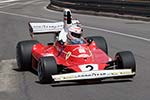
|
|
|
Ferrari 312 T
|
76

|
| Years of production: |
1975 - 1976 |
| Last updated: |
02 / 19 / 2016 |
|
|
|
|
| |
|
|
|
|
| |
|
|
|
|
| |
|
|
|
|
| |
|
|
|
|
| |
|
|
|
|
| |
|
|
|
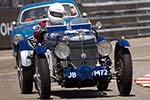
|
|
|
MG Magnette K3
|
37

|
| Years of production: |
1933 - 1934 |
| Last updated: |
05 / 19 / 2008 |
|
|
| |
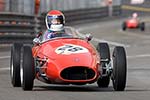
|
|
|
OSCA Tipo J
|
29

|
| Years of production: |
1959 - 1961 |
| Last updated: |
12 / 08 / 2008 |
|
|
|
|
| |
|
|
|
|
| |
|
|
|
|
| |
|
|
|
|
| |
|
|
|
|
| |

 A win in a Formula 1 car at Monaco ranks very high among motor racing aficionados. Until recently only racing drivers the likes of Ayrton Senna, Graham Hill and Stirling Moss were able to claim victory in the Principality. Among them they won no fewer than 14 times, underlining that only the greatest are successful on the tricky street circuit. Almost as famous are the many accidents like Albert Ascari's d(r)ive into the harbour in 1955. To give the slightly less talented enthusiasts a chance to aim for an F1 win at Monaco, the Automobile Club de Monaco (ACM) first organized the Monaco Historic Grand Prix in 1997. The now bi-annual event was held for the sixth time in 2008. Looking back at past winners there is a clear resemblance with the 'real' Monaco Grand Prix; the same names pop up as winners time and again. Most successful of all was Martin Stretton, who had won at least one race at each of the previous editions. Last time we saw him, at the 2007 Goodwood Revival, he was rushed to hospital, but fortunately he recovered fully in time to try and continue his winning streak.
A win in a Formula 1 car at Monaco ranks very high among motor racing aficionados. Until recently only racing drivers the likes of Ayrton Senna, Graham Hill and Stirling Moss were able to claim victory in the Principality. Among them they won no fewer than 14 times, underlining that only the greatest are successful on the tricky street circuit. Almost as famous are the many accidents like Albert Ascari's d(r)ive into the harbour in 1955. To give the slightly less talented enthusiasts a chance to aim for an F1 win at Monaco, the Automobile Club de Monaco (ACM) first organized the Monaco Historic Grand Prix in 1997. The now bi-annual event was held for the sixth time in 2008. Looking back at past winners there is a clear resemblance with the 'real' Monaco Grand Prix; the same names pop up as winners time and again. Most successful of all was Martin Stretton, who had won at least one race at each of the previous editions. Last time we saw him, at the 2007 Goodwood Revival, he was rushed to hospital, but fortunately he recovered fully in time to try and continue his winning streak.




